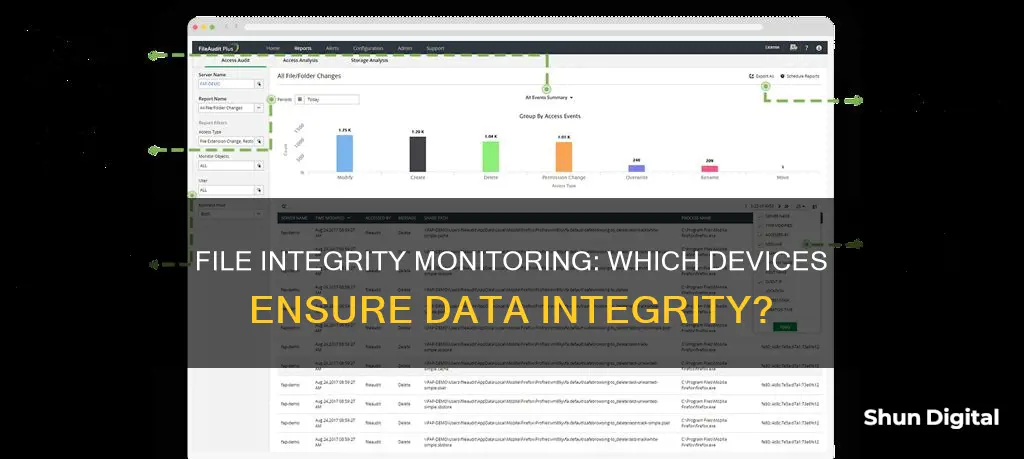
File Integrity Monitoring (FIM) is a security process that monitors and analyses the integrity of critical assets, including file systems, directories, databases, network devices, the operating system (OS), OS components and software applications for signs of tampering or corruption, which may be an indication of a cyberattack. FIM tools rely on two different verification methods to verify the integrity of critical file systems and other assets: reactive or forensic auditing; and proactive or rules-based monitoring.
| Characteristics | Values |
|---|---|
| Name | File Integrity Monitoring (FIM) |
| Purpose | Security mechanism that analyzes critical system files to check for unauthorized modifications and cyberattacks |
| Function | Monitors and analyzes the integrity of critical assets, including file systems, directories, databases, network devices, the operating system (OS), OS components and software applications for signs of tampering or corruption |
| Verification Methods | Reactive or forensic auditing; and proactive or rules-based monitoring |
| Comparison Method | Calculating a known cryptographic checksum of the file's original baseline and comparing with the calculated checksum of the current state of the file |
| Monitoring | Can be performed randomly, at a defined polling interval, or in real-time |
| Compliance | PCI DSS, SOX, NERC CIP, FISMA, HIPAA, SANS Critical Security Controls, GDPR, ISO 17799 |
What You'll Learn

File Integrity Monitoring (FIM) tools
FIM tools utilise two main verification methods: reactive or forensic auditing, and proactive or rules-based monitoring. By comparing the current file state with a known, good baseline, organisations can identify unexpected or unauthorised modifications. This process involves calculating cryptographic checksums of the file's original baseline and comparing them with the calculated checksum of the current state. Additionally, other file attributes, such as privileges, security settings, core attributes, size, and configuration values, can be monitored for changes.
Some common FIM tools available in the market include Advanced Intrusion Detection Environment, Another File Integrity ChecKer, Kaspersky Lab Hybrid Cloud Security, McAfee Change Control, Netwrix-NNT Change Tracker, System File Checker (for Windows), Tanium Integrity Monitor, and Trend Micro Deep Security.
When selecting a FIM tool, organisations should consider compatibility, customisation, and the ability to support existing file integrity policies. It is also important to evaluate the tool's ability to automate and streamline regulatory compliance efforts and its scalability to adapt to future needs.
FIM plays a crucial role in detecting cyberattacks, expediting threat detection and response, identifying weaknesses within the IT infrastructure, and streamlining compliance with regulations such as HIPAA, GDPR, and PCI DSS. By continuously monitoring and verifying the integrity of critical assets, organisations can enhance their security posture and protect their sensitive data.
Monitoring Internet Usage: Workgroup Strategies for IT Pros
You may want to see also

FIM verification methods
File Integrity Monitoring (FIM) is a security process that uses verification methods to monitor and analyse the integrity of critical assets, including file systems, directories, databases, network devices, the operating system (OS), OS components and software applications. FIM tools rely on two different verification methods: reactive or forensic auditing, and proactive or rules-based monitoring.
In the reactive or forensic auditing method, FIM tools compare the current file state with a known, good baseline to detect any tampering, corruption or suspicious modifications. This involves calculating a cryptographic checksum of the file's original baseline and comparing it with the calculated checksum of the current state of the file. If any unauthorised changes are detected, the FIM tool will alert the information security team.
The proactive or rules-based monitoring method involves establishing a baseline with a cryptographic hash signature applied to each file. Any changes made to the files, authorised or not, will change the hash value, making it easy to detect updates and alterations. The FIM tool compares the hash values on the files to detect anomalous changes and alerts the information security team if necessary.
FIM provides an important layer of protection for sensitive files, data, applications and devices by routinely scanning, monitoring and verifying the integrity of those assets. It helps organisations detect cyberattacks, expedite threat detection and remediation, identify weaknesses within the IT infrastructure, and streamline compliance efforts.
Furloughed Inmates: Ankle Monitors and Tracking Technology
You may want to see also

FIM and regulatory compliance
File Integrity Monitoring (FIM) is a security process that validates the integrity of operating system and application software files. FIM is a crucial component of regulatory compliance, helping organizations maintain control over their data and prevent breaches.
FIM tools use verification methods to compare current files with a baseline, triggering alerts if any unauthorized changes are detected. This is essential for maintaining compliance with regulations such as the Health Insurance Portability and Accountability Act (HIPAA), Payment Card Industry Data Security Standard (PCI DSS), Sarbanes-Oxley Act (SOX), and General Data Protection Regulation (GDPR). For example, PCI DSS Requirement 11.5 specifies the need for FIM or a change detection mechanism to alert security personnel about unauthorized modifications.
FIM helps organizations streamline their compliance efforts by continuously monitoring and verifying the integrity of sensitive files, data, applications, and devices. It also assists in identifying potential security issues and improving the accuracy of incident response. By implementing FIM, organizations can detect cyberattacks early on, expedite threat detection and remediation, and identify weaknesses within their IT infrastructure.
Additionally, FIM simplifies regulatory compliance by providing detailed audit trails of file modifications, ensuring data accuracy, and maintaining data integrity. It is a powerful tool for organizations to protect their critical assets and simplify compliance in a complex regulatory landscape.
To maximize the benefits of FIM, organizations should consider integrating it with their existing security solutions and selecting a customizable and compatible FIM tool that aligns with their specific needs and requirements.
Powering Your LCD Monitor with a Power Bank
You may want to see also

FIM solutions
File Integrity Monitoring (FIM) solutions are an important tool in the fight against cybercrime. FIM solutions are a set of security practices that continuously verify the integrity of critical assets, including file systems, directories, databases, network devices, the operating system (OS), OS components, and software applications. FIM solutions monitor changes to specific files to detect potential security threats.
When choosing a FIM solution, it is important to consider its compatibility with the organization's existing cybersecurity architecture, its ability to support specific threat detection and remediation use cases, and its scalability and integration with other security tools.
Some examples of FIM solutions include ManageEngine's DataSecurity Plus, SolarWinds' Security Event Manager, and Qualys' FIM software. These tools offer features such as tracking file and directory access, movement, and shares, generating alerts, and providing compliance reporting.
Monitor Size: Impact on Eyesight and Vision
You may want to see also

FIM and cyberattacks
File integrity monitoring (FIM) is a critical security control that helps organizations proactively block attacks and detect threats in their early stages. It is a set of security practices that continuously verify the authenticity of file systems, operating system components, applications, and databases. FIM works by monitoring changes in two types of files: system files and configuration files.
System files are the binary program files that provide the core functionality for a device, platform, or application. Configuration files store the settings that govern the security and operational characteristics of a platform, device, or application. By monitoring these files, FIM can help to identify potential security breaches and maintain the integrity of data.
FIM is particularly important in detecting and responding to cyberattacks, such as phishing, ransomware, insider threats, and zero-day exploits. In the early stages of a complex cyberattack, cybercriminals may need to alter critical files related to the operating system or applications. FIM tools can detect such modifications because they review the current file against a baseline, rather than simply reviewing the file logs. This allows organizations to detect threats early in the cyber kill chain and stop the breach before significant or costly damage is done.
FIM can also aid in incident response by providing a record of changes to files that can assist in forensic investigations. By detecting any changes to files or system configurations, FIM can help identify the source of the attack, the extent of the damage, and any stolen data.
In addition to its security benefits, FIM also plays a crucial role in compliance. Regulations such as the Payment Card Industry Data Security Standard (PCI DSS), the Health Insurance Portability and Accountability Act (HIPAA), the General Data Protection Regulation (GDPR), and the California Consumer Privacy Act (CCPA) require organizations to monitor and protect sensitive information. FIM enables organizations to demonstrate that they are implementing proper security controls and monitoring and detecting and reporting any security incidents in a timely and appropriate manner.
Removing Subscriptions from Replication Monitor: A Step-by-Step Guide
You may want to see also
Frequently asked questions
File integrity monitoring (FIM) is a security process that monitors and analyzes the integrity of critical assets, including file systems, directories, databases, network devices, the operating system (OS), OS components and software applications for signs of tampering or corruption, which may be an indication of a cyberattack.
File integrity monitoring works by creating a baseline of data file integrity from a known, secure state of system files. When a change is detected, the change is checked against this baseline to determine if it’s a legitimate modification or potential threat.
Adopting a file integrity monitoring solution can provide organizations with benefits such as enhanced security, compliance, streamlined troubleshooting, and decreased downtime.







